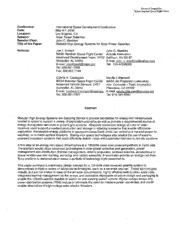
Modular High-Energy Systems for Solar Power Satellites PDF
Preview Modular High-Energy Systems for Solar Power Satellites
Source of Acquisition NASA Marshall Space night Center Conference: International Space Development Conference Date: May 4-7,2006 Location: Los Angeles, CA Session: Solar Power Satellites Session Chair: John C. Mankins Title of the Paper: Modular High-Energy Systems for Solar Power Satellites Authors : Joe T. Howell John C. Mankins NASA Marshall Space Flight Center Artemis Innovation Advanced Development Team, VP33 Ashburn, VA 20147 Huntsville, AL 35812 E-mail: john c [email protected] E-mail: [email protected] Tel: 703-47209286 Tel: 256-961- 7566 Fax: 256-961-7149 Connie K. Carrington Neville I. Marzwell NASA Marshall Space Flight Center NASA Jet Propulsion Laboratory Advanced Vehicle Sensors, EV21 Adv. Concepts - Tech. Innovation Huntsville, AL 35812 Pasadena, CA 91 109 E-mail: Connie.K.CarrinatonQnasa.aov E-mail: [email protected],nov Tel: 256-961- 7557 Tel: 81 8-345-6543 Abstract Modular High-Energy Systems are Stepping Stones to provide capabilities for energy-rich infrastructure located in space to support a variety of exploration scenarios as well as provide a supplemental source of energy during peak demands to ground grid systems. Abundant renewable energy at lunar or other locations could support propellant production and storage in refueling scenarios that enable affordable exploration. Renewable energy platforms in geosynchronous Earth orbits can collect and transmit power to satellites, or to Earth-surface locations. Energy-rich space technologies also enable the use of electric- powered propulsion systems that could efficiently deliver cargo and exploration facilities to remote locations. A first step to an energy-rich space infrastructure is a 100-kWe class solar-powered platform in Earth orbit. The platform would utilize advanced technologies in solar power collection and generation, power management and distribution, thermal management, electric propulsion, wireless avionics, autonomous in space rendezvous and docking, servicing, and robotic assembly. It would also provide an energy-rich free- flying platform to demonstrate in space a portfolio of technology flight experiments. This paper summary a preliminary design concept for a 100-kWe solar-powered satellite system to demonstrate in-flight a variety of advanced technologies, each as a separate payload. These technologies include, but are not limited to state-of-the-art solar concentrators, highly efficient multi-junction solar cells, integrated thermal management on the arrays, and innovative deployable structure design and packaging to enable the 100-kW satellite feasible to launch on one existing launch vehicle. Higher voltage arrays and power distribution systems (PDS) reduce or eliminate the need for massive power converters, and could enable direct-drive of high-voltage solar electric thrusters. Conference: International Space Development Conference Date: May 4-7,2006 Location: Los Angeles, CA Session: Solar Power Satellites Session Chair: John C. Mankins Title of the Paper: Modular High-Energy Systems for Solar Power Satellites Authors: Joe T. Howell Neville I. Marzwell NASA Marshall Space Flight Center NASA Jet Propulsion Laboratory - Advanced Development Team, VP33 Adv. Concepts Tech. Innovation Huntsville, AL 35812 Pasadena, CA 911 09 E-mail: [email protected] E-mail: Neville.l.MarzwellbiriDl.nasa.aov Tel: 256-961- 7566 Tel: 81 8-345-6543 Fax: 256-961- 7149 Connie K. Carrington John C. Mankins NASA Marshall Space Flight Center Artemis Innovation Advanced Vehicle Sensors, EV21 Ashburn, VA 20147 Huntsville, AL 35812 E-mail: john c [email protected] E-mail: Connie.K.Carrinntonbnasa.aov Tel: 703-47209286 Tel: 256-961-7557 Abstract Modular High-Energy Systems are Stepping Stones to provide capabilities for energy-rich infrastructure located in space to support a variety of exploration scenarios as well as provide a supplemental source of energy during peak demands to ground grid systems. Abundant renewable energy at lunar or other locations could support propellant production and storage in refueling scenarios that enable affordable exploration. Renewable energy platforms in geosynchronous Earth orbits can collect and transmit power to satellites, or to Earth-surface locations. Energy-rich space technologies also enable the use of electric- powered propulsion systems that could efficiently deliver cargo and exploration facilities to remote locations. A first step to an energy-rich space infrastructure is a 100-kWe class solar-powered platform in Earth orbit. The platform would utilize advanced technologies in solar power collection and generation, power management and distribution, thermal management, electric propulsion, wireless avionics, autonomous in space rendezvous and docking, servicing, and robotic assembly. It would also provide an energy-rich free- flying platform to demonstrate in space a portfolio of technology flight experiments. This paper summary a preliminary design concept for a 100-kWe solar-powered satellite system to demonstrate in-flight a variety of advanced technologies, each as a separate payload. These technologies include, but are not limited to state-of-the-art solar concentrators, highly efficient multi-junction solar cells, integrated thermal management on the arrays, and innovative deployable structure design and packaging to enable the 100-kW satellite feasible to launch on one existing launch vehicle. Higher voltage arrays and power distribution systems (PDS) reduce or eliminate the need for massive power converters, and could enable direct-drive of high-voltage solar electric thrusters. s 0 4J an & 1 L o w W L B a, c w a, T3 3 1u111 S .I 0 4-J T3 3 v) v) m cy L m 4-J 8 b u S Q c e v, a I p 0% 'E €3 9 9 9 9 9- 9 0 8 9 0 0 0 0 0 0 Lmo 0m Lo 0 Lo 0 (v (v F Lo -4- \ € .3- .-U- L E E 0 0 8 CI) a (3 T 0
